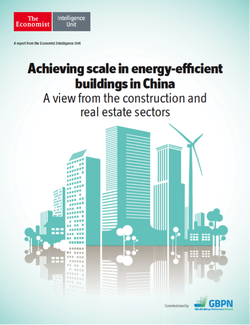[Report] China could cut carbon emissions significantly with incentives for energy efficient buildings
New Report by the Economist Intelligence Unit and the Global Buildings Performance Network Identifies Key Issues for Scaling Up Efficiency in Buildings in China

Twenty eight (28%) of China’s carbon dioxide emissions originate from energy use in buildings. Government programs to promote green buildings are well received by the country’s growing private sector, which is increasingly investing in buildings that meet national and international green certification standards. However, greater awareness of cost savings, clearer regulation and easier access to domestic financing are necessary to achieve scale and mitigate carbon emissions. These were some key findings from an Economist Intelligence Unit report, Achieving scale in energy-efficient buildings in China: A view from the construction and real estate sectors, commissioned by the Global Buildings Performance Network (GBPN) in collaboration with the Energy Foundations’ China Sustainable Energy Program (CSEP), and in partnership with the World Business Council for Sustainable Development (WBCSD).
Other findings include:
- Low awareness of the potential cost savings restricts demand for energy-efficient building in China. Chinese buyers are price-sensitive and don’t yet understand the savings associated with energy-efficient buildings.
- Until recently, developers have had little incentive to spend extra for energy-efficient construction, but new government programs are helping build a better business case. Last year, $8.5m in government subsidies was made available to each “ecological” district that meets green building standards.
- The private sector is helping fuel demand for energy-efficient buildings. Companies are increasingly drawn to buildings that meet national and international green certification standards; they are also looking to meet their corporate social responsibility (CSR) objectives.
- Increasing government subsidies and international funding compensates for gaps in finance provided by Chinese banks. China’s commercial banks are wary of lending for construction of energy-efficient buildings as such projects are often considered more costly, thus requiring greater investment.
Chinese government is advancing on programs to promote energy-efficient buildings, but incentives for and demand for such constructions should continue to be developed. Companies are looking for easier access to financing and are not afraid of more stringent legislation. Achieving rapid scale up of energy efficient building will also depend on encouraging demand through raising awareness from homebuyers to corporations— who must see better value in energy-efficient buildings.
Analysis from experts of the GBPN network – Watch the video:
This Case Study report about China is a follow-up to the EIU global report published last October, Energy efficiency and energy savings – a view from the building sector.
Other formats of this report:
Also consult the October global report:
- Energy Efficiency and Energy Savings: A View from the Building Sector, October 2012
- Highlights
- Briefing
- Multimedia
This report is part of a series of case study reports by the EIU commissioned by the GBPN in collaboration with its Regional Hubs and Partners about invvesting in energy efficiency in buildings in China, Europe, India and the U.S. (Our Network).
Links
Related Report Bundles
Share This Story, Choose Your Platform!
Stay in touch with how we’re transforming the buildings sector
GBPN runs innovative building policy reform programs in key regions around the world that aim to tackle the climate emergency by decarbonising the buildings sector. Stay up to date with our newsletter.
Stay in touch with how we’re transforming the buildings sector
GBPN runs innovative building policy reform programs in key regions around the world that aim to tackle the climate emergency by decarbonising the buildings sector. Stay up to date with our newsletter.




